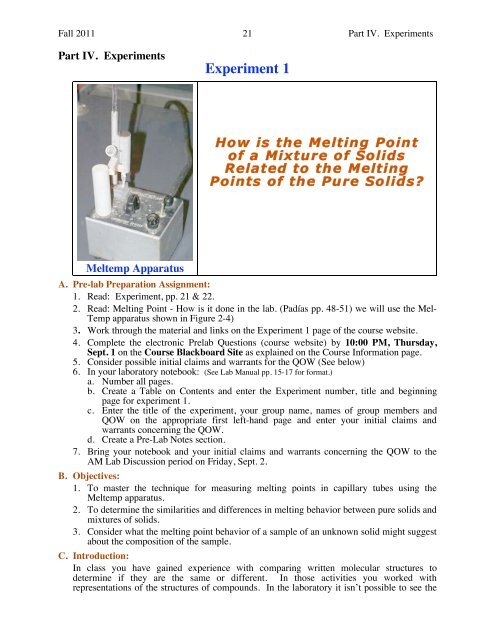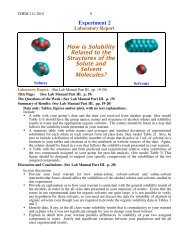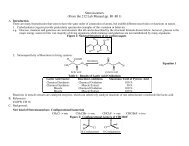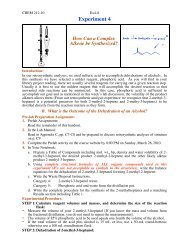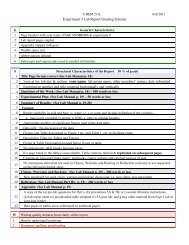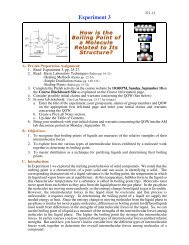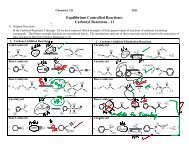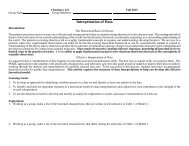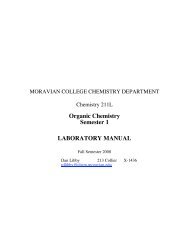Pre-Lab Preparation Sheet
Pre-Lab Preparation Sheet
Pre-Lab Preparation Sheet
Create successful ePaper yourself
Turn your PDF publications into a flip-book with our unique Google optimized e-Paper software.
Fall 2011 21 Part IV. Experiments<br />
Part IV. Experiments<br />
Experiment 1<br />
How is the Melting Point<br />
of a Mixture of Solids<br />
Related to the Melting<br />
Points of the Pure Solids<br />
Meltemp Apparatus<br />
A. <strong>Pre</strong>-lab <strong>Pre</strong>paration Assignment:<br />
1. Read: Experiment, pp. 21 & 22.<br />
2. Read: Melting Point - How is it done in the lab. (Padías pp. 48-51) we will use the Mel-<br />
Temp apparatus shown in Figure 2-4)<br />
3. Work through the material and links on the Experiment 1 page of the course website.<br />
4. Complete the electronic <strong>Pre</strong>lab Questions (course website) by 10:00 PM, Thursday,<br />
Sept. 1 on the Course Blackboard Site as explained on the Course Information page.<br />
5. Consider possible initial claims and warrants for the QOW (See below)<br />
6. In your laboratory notebook: (See <strong>Lab</strong> Manual pp. 15-17 for format.)<br />
a. Number all pages.<br />
b. Create a Table on Contents and enter the Experiment number, title and beginning<br />
page for experiment 1.<br />
c. Enter the title of the experiment, your group name, names of group members and<br />
QOW on the appropriate first left-hand page and enter your initial claims and<br />
warrants concerning the QOW.<br />
d. Create a <strong>Pre</strong>-<strong>Lab</strong> Notes section.<br />
7. Bring your notebook and your initial claims and warrants concerning the QOW to the<br />
AM <strong>Lab</strong> Discussion period on Friday, Sept. 2.<br />
B. Objectives:<br />
1. To master the technique for measuring melting points in capillary tubes using the<br />
Meltemp apparatus.<br />
2. To determine the similarities and differences in melting behavior between pure solids and<br />
mixtures of solids.<br />
3. Consider what the melting point behavior of a sample of an unknown solid might suggest<br />
about the composition of the sample.<br />
C. Introduction:<br />
In class you have gained experience with comparing written molecular structures to<br />
determine if they are the same or different. In those activities you worked with<br />
representations of the structures of compounds. In the laboratory it isn’t possible to see the
Part V. Experiments 22 Fall 2011<br />
structure of a substance. So chemists define substances on the basis of an accumulation of<br />
observable properties. For example, when we say "water," we mean "that clear, colorless,<br />
odorless liquid with a boiling point of 100°C, freezing point of 0°C, a density of 1 g/ml that<br />
dissolves substances like salt, that upon electrolysis gives a mixture of hydrogen and oxygen<br />
gases in a definite ratio"...and so forth. Using our molecular metaphor of matter we interpret<br />
the properties of "water" in terms of a molecular structure, H-O-H. Thus to identify a<br />
compound, it is critical to be able to determine and compare the physical properties of<br />
substances accurately and reproducibly.<br />
Experiment 1 introduces you to a simple but important measurement technique,<br />
determination of the melting point of a solid sample, by using it to explore how one<br />
substance may or may not affect another when they are mixed. To facilitate gathering a large<br />
amount of data, you will you will be working in groups. Modern science involves a lot of<br />
teamwork. So Experiment 1 provides you experience in collaboration with colleagues in the<br />
lab to answer an experimental question.<br />
D. Question of the Week:<br />
How is the melting point of a 50:50 mixture of solids related to the<br />
melting points of the two pure solids used for the mixture<br />
View the pre-lab clip of a pure compound melting in a capillary tube. Then consider how<br />
you would expect a mixture of two different compounds with mps of 50˚C and 150˚C<br />
respectively to behave when heated in a similar Meltemp device. How might the melting<br />
behavior of a mixture of two different compounds with mps of 95˚C and 105˚C compare with<br />
that of the first mixture or of that of individual pure compounds Be prepared to present the<br />
warrants that led to your claims.<br />
E. Safety Matters:<br />
1. Safety goggles are required.<br />
2. Shoes must cover the tops of your feet.<br />
3. Clothing that covers from neck to knees.<br />
4. Avoid skin contact with solid compounds and wash your hands periodically during the<br />
laboratory period.<br />
F. Key Terms/concepts/techniques:<br />
1. The Melting Point.<br />
2. The Meltemp Apparatus.


